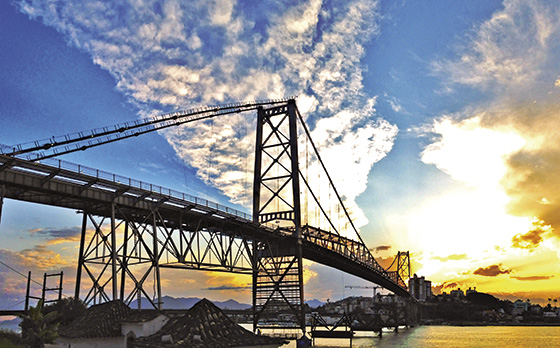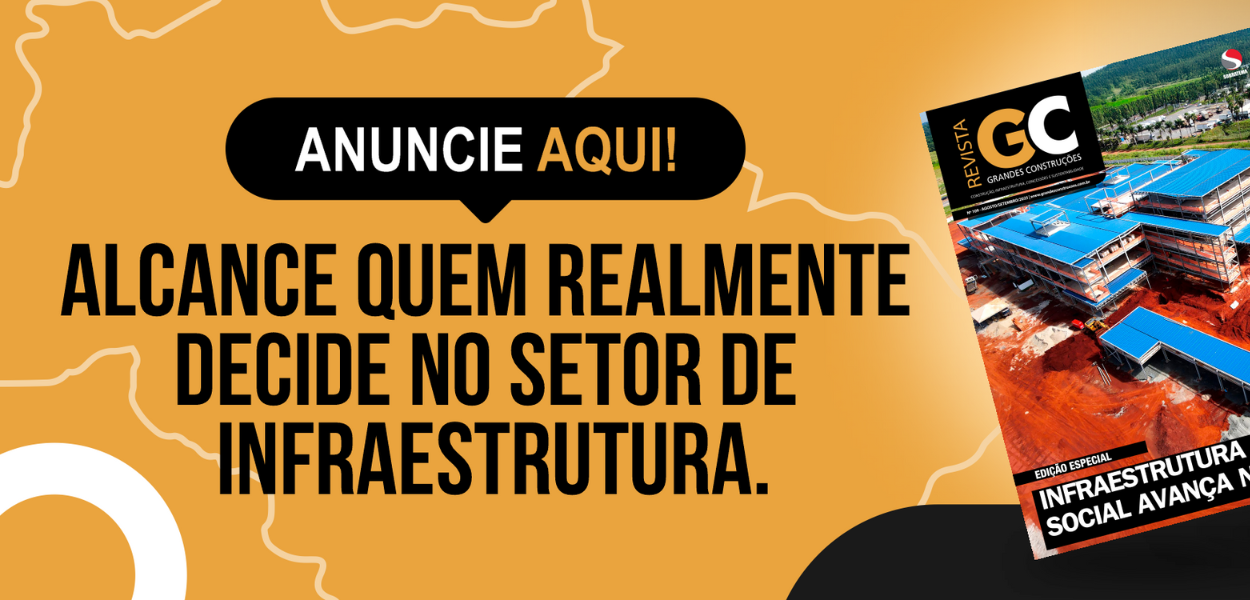Hercílio Luz is a model in the recovering of historic metallic bridges

The bridge will be supported by a temporary metallic structure assembled on underwater pillars built at a depth of 30 m. This structure will be used until the complete recovery of the original structure of the bridge
By Paulo Espírito Santo
The old “iron lady”, tender nickname given by the people of Santa Catarina to the Hercílio Luz Bridge, located in Florianópolis (SC), will soon be using new clothes. Main monument and architectural symbol of the region, the metallic bridge—designed in 1922 and concluded in 1926—is passing by a long program of refurbishment that was going on through the last 11 years. After countless interruptions due to several reasons, the state government guarantees that the works—that now reached approximately 20 percent of physical advance—will not stop.
Works are scheduled to be concluded in 30 months counted from the start of this phase, occurred in April 18, 2016. Preserved and protected by institutes of defense of the historical assets of the Federal, State and City Government, the Bridge Hercilio Luz is interdicted for the traffic of vehicles since 1982. From 1991 on, its access was also forbidden for pedestrians. According to a technical report issued by the Instituto de Pesquisas Tecnológicas (IPT), the reason was the deteriorating state of its metallic structures due to the lack of maintenance. Since its opening, the bridge is suffering constant aggressions by the harsh environment where it is located, such as the corrosive action of the sea, which causes accumulation of saltpeter in several parts. Such aggressions were worsened along the years with the increase of load due to the growing number of vehicles that were passing by, much higher than that foreseen in the original design.
The bridge is formed by a central span with 339.471 meters, plus an insular viaduct with 259 meters and a continental viaduct with 221 meters, corresponding to a total of 819.471 meters. The central span is 43 meters above the sea level. Both towers are 75 meters above the sea level. The total weight of the structure is 5,000 tons.
Complete rebuilding
Budgeted in R$ 262.9 million that will come from the government of Santa Catarina, from the municipality of Florianópolis and from the BNDES, the program of rebuilding foresees the change of large sections of the original structure of the bridge, including the 12 to 13 m long bars with eyebolts in their ends, hanging bars, structural bearings, tower saddles and deck of the hanging span, main towers, pedestrian catwalks and traffic lanes.
Once refurbished, the “iron lady” will come to operate again as part of the road system of the city. Traffic estimation is of 20 percent of the vehicles currently going through the two existing bridges that connect the Island of Santa Catarina to the continent: Colombo Salles and Pedro Ivo.
All cross beams and spars that compose the central span lattice were already replaced. This service was carried out very quickly due to the use of four tower cranes that are working in that section. Tower cranes remove the old parts and lift and position the new parts that are bolted initially and riveted later.
The project had the technical consulting of American Bridge, American contractor that designed and built the original bridge. To allow the progress in changing worn parts, it was necessary to build an auxiliary structure to support the central span of the Hercílio Luz bridge, relieving this way the load currently supported by the sustaining towers and the eyebolt bars.
The auxiliary structure is composed by four underwater supporting pillars that end in V-shaped steel structures. A metallic lattice positioned on these structures will be the supporting base for the bridge. All this auxiliary structure and the other parts to be replaced were assembled in the three worksites located in the headboards of the bridge and transported to the replacement points with the help of three barges and several tugboats.
Part of these components that were transported by the barges are riveted components—a very old technique—produced by Brafer, “that had to customize itself mixing modern equipment and working processes with a centenary technique of union”, explains José Augusto, Executive Director of the company.
Precision under water
The bases of the pillars received concrete with special additives to reach the resistance specified in their design. The concrete used to reinforce the metallic pillars was pumped to 30 m below the sea level and then injected to more 7.5 meters deep to penetrate in the holes made in the underwater rocks. Concrete pouring in the pillars and the installation of precast blocks on the piles consumed 9,000 cu.mt. of concrete.
The work of divers in welding the metallic structures facing strong sea currents was necessary to build the underwater pillars. They just could stay few minutes submerged to weld the struts in the bottom of the sea with millimeter-sized precision to allow the perfect fitting of the angles.
A metallic lattice was assembled on these four pillars. This structure works as a “table” to support the temporary metallic structure, designed to support the loads of the central span during the restoration. The construction of the pillars was concluded in 2015 by the consortium Florianópolis Monumento, formed by the contractors CSA Group, Inc, headquartered in Miami—one of the largest companies of engineering, management and development of high-complexity infrastructure works in the United States—and the Construtora Espaço Aberto, working for more than 30 years in the market and responsible by important projects in Santa Catarina.
Even with the underwater part concluded, the consortium could not carry out the remaining works in the scheduled times. This situation leaded the government of the State of Santa Catarina to terminate the contract unilaterally.
The phase of rebuilding the suspension structure was awarded to the Portuguese group Teixeira Duarte (EMPA) and to RMG Engenharia. According to an inspection carried out by the engineers Hermes Carvalho and Francisco Carlos Rodrigues, from the department of structure engineering from the Federal University of Minas Gerais (UFMG),the pathologies were so much that practically was necessary to build a new bridge. In fact, the construction of a new structure would be cheaper than the set of actions needed to refurbish the original bridge. This will not happen just due to the heritage preservation of the structure and its historical value.
Load transfer
To rebuild the entire supporting structure of the central span, all the weight of the bridge—currently supported by the sustaining columns located at the borders of the bay—will be transferred to the temporary structure that is being built. The load transfer will be carried out by two ranges of 27 special hydraulic jacks that will raise the entire structure to an approximated height of 55 centimeters. The operation of these jacks will be coordinated with the help of a software to be designed especially for this purpose.
Wenceslau Diotallevy, from the Departamento Estadual de Infraestrutura (Deinfra), highlights the importance of the steel originally used to build the bridge as an important factor for the survival time of the structure. “We were surprised—during the analyses carried out on the materials—to note that raw materials produced almost a century ago in the United States are very similar to the steel produced currently. Both specs are quite similar”, says him. This would make easier the maintenance of the entire bridge along all these decades.

Av. Francisco Matarazzo, 404 Cj. 701/703 Água Branca - CEP 05001-000 São Paulo/SP
Telefone (11) 3662-4159
© Sobratema. A reprodução do conteúdo total ou parcial é autorizada, desde que citada a fonte. Política de privacidade










